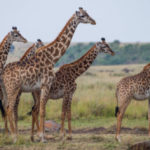 Technology
Technology  Technology
Technology  Our World
Our World 10 Ways Icelandic Culture Makes Other Countries Look Boring
 Misconceptions
Misconceptions 10 Common Misconceptions About the Victorian Era
 Mysteries
Mysteries 10 Strange Unexplained Mysteries of 2025
 Miscellaneous
Miscellaneous 10 of History’s Most Bell-Ringing Finishing Moves
 History
History 10 Great Escapes That Ended Right Back in Captivity
 Weird Stuff
Weird Stuff 10 Fascinating Things You Might Not Know About Spiders
 Food
Food 10 Everyday Foods You Didn’t Know Were Invented by the U.S. Military
 History
History 10 Odd Things Colonial Americans Kept at Home
 Weird Stuff
Weird Stuff 10 Superstitious Beliefs That Once Consumed Entire Cultures
 Technology
Technology 10 Scientific Breakthroughs of 2025 That’ll Change Everything
 Our World
Our World 10 Ways Icelandic Culture Makes Other Countries Look Boring
 Misconceptions
Misconceptions 10 Common Misconceptions About the Victorian Era
Who's Behind Listverse?

Jamie Frater
Head Editor
Jamie founded Listverse due to an insatiable desire to share fascinating, obscure, and bizarre facts. He has been a guest speaker on numerous national radio and television stations and is a five time published author.
More About Us Mysteries
Mysteries 10 Strange Unexplained Mysteries of 2025
 Miscellaneous
Miscellaneous 10 of History’s Most Bell-Ringing Finishing Moves
 History
History 10 Great Escapes That Ended Right Back in Captivity
 Weird Stuff
Weird Stuff 10 Fascinating Things You Might Not Know About Spiders
 Food
Food 10 Everyday Foods You Didn’t Know Were Invented by the U.S. Military
 History
History 10 Odd Things Colonial Americans Kept at Home
 Weird Stuff
Weird Stuff 10 Superstitious Beliefs That Once Consumed Entire Cultures
Ten Animals That Are More Musical Than You Might Think
The animal kingdom is a hotbed of shocking musical talent. Take the elephant harmonica players, for example, or the bats with death metal growls. While some species might be content to whip up some awful din, these critters develop rhythms, sing like humans, and in the case of the palm cockatoo, even whittle their own drumsticks. From a groovy sea lion that loves disco to a cat playing the piano, here are ten of nature’s most adept maestros.
Related: 10 Animals That Turned Out to Be Hoaxes or Spoofs
10 West African Chimps Beat Their Own Drum
Deep in the rainforests of West Africa, chimpanzees are getting their groove on. The percussionist primates have a whale of a time banging on tree roots with their hands and feet. The creatures use rhythm to send information to one another, creating sounds that can be heard over a kilometer away in the foliage. Each chimp has its own trademark style. They use their beats to tell their buddies where and what they are up to.
The primates aren’t just randomly bashing away either. A 2025 study discovered that the drumming chimps have rhythm, even sharing certain features with human music. It suggests that our prehistoric ancestors could have enjoyed music long before humans existed. There are even different rhythms for different subspecies.
Researcher Vesta Eleuteri explained, “While chimpanzees from West Africa—like humans—often drum isochronously, which is when sounds occur one after another with the exact same amount of time between them: like the ticking of a clock, or the kick drum in electronic music. Chimpanzees from East Africa prefer to alternate short and long intervals in their drumming.”[1]
9 Bats Growl like Death Metal Singers
Metal bands tend to love all things gothic and spooky, and bats are no exception. But the swooping mammals have more in common with the extreme genre than you might have thought. The creatures let out death metal growls at one another. They create dark, guttural roars using the ventricular folds, found just above the vocal cords. These folds are rarely used by humans, usually only by death metal vocalists and Tuvan throat singers.
Bats produce high-frequency chirps for echolocation to detect nearby objects. But these sounds fade away after a few meters. If they need their vocals to travel further, the nocturnal flutterers use their gruff death metal-style growls to communicate with each other.
“The oscillations become very irregular,” researcher Coen Elemans told reporters. “They become very rough, and that’s what you get with death metal grunting.”[2]
8 Ronan the Sea Lion Is an Expert Groover
A marine center in California is home to what might be the world’s grooviest sea lion. Ronan is a remarkable mover. She can pick up a beat and move her head to it, a feat rarely seen besides humans, parrots, and some primates. The dancing pinniped was rescued as a child and has lived at the Joseph M. Long Marine Laboratory in Santa Cruz for 12 years. Researchers at the lab helped her perfect her rhythmic skills.
Ronan bops along to a range of music, from rock to electronica. But she does her best work to disco tunes like the classic Boogie Wonderland. Scientists challenged her to bop along to drum beats at three different tempos and asked 10 students to do the same. Ronan outperformed them all.
“No human was better than Ronan at all the different ways we test quality of beat-keeping,” said researcher Peter Cook. “She’s much better than when she was a kid.” The team is now keen to learn if other sea lions can move to the groove like Ronan, or if she is truly the greatest dancer.[3]
7 Shanthi the Elephant Played Harmonica at U.S. Zoo
The harmonica is a classic instrument, put to great use by artists across the musical spectrum, from Bob Dylan to Stevie Wonder. And, of course, Shanthi, an Asian elephant who lived at the Smithsonian’s National Zoo in Washington. The mouth organ maestro used her trunk to blow out her tunes, often ending on a crescendo. Quite the showwoman.
Her keepers say she loved playing to entertain visitors, but also enjoyed a cheeky toot when no one was around. She was also fond of tapping objects and flapping her huge ears against them to make noise. One New Year’s, she even made a racket with a plastic party horn, although the reviews from keepers were less than glowing. “It sounded like she was strangling a goose,” one said. Sadly, Shanthi died in 2020, but the tradition of elephants playing harmonicas lives on.[4]
6 Rock Hyraxes Sing Human Rhythms to Entice a Mate
The song of a rock hyrax might not sound like much to us. Some describe their voice as a hyena’s cackle mixed with a screeching blackboard. However, a male rock hyrax balladeer can drive the females wild with desire, as long as he can hold a steady tune. A 2022 study found that the furry critters who sing most often and keep the best rhythm get the most female attention. Not only that, their offspring are also more likely to survive.
“The most simple explanation is that being consistent in terms of rhythm is attractive, or at least reflects quality in some way,” explained behavioral ecologist Vlad Demartsev. “It’s not just that they’re producing the signal. It’s not even that they’re producing the signal as many times as possible. It’s that they’re actually putting on a good show.”[5]
5 Nora, the Piano Playing Cat
The internet loves a cat video, as evidenced by the viral success of Nora, a grey tabby from New Jersey. Piano teacher Betsy Alexander adopted the talented feline as a kitten. She used to watch as students came to the house to practise, often sitting under the piano as the budding musicians played.
Then, when she was around a year old, she decided to have a go for herself. She jumped on the stool and put her paws on the keys. Before too long, Nora played almost every day, sometimes even dueting with the students. Videos of her performances were massive hits on YouTube, amassing millions of views.
In 2009, conductor Mindaugas Piecaitis incorporated Nora’s playing into a four-minute orchestral CATcerto. She won Cat of the Year from New York’s Westchester Feline Club. Her owners released books and DVDs of her work. Sadly, as she grew older, arthritis set in, and she was unable to play the piano as much. She died in February 2004, surrounded by her owners on her favorite blanket.[6]
4 Lemurs Sing Using Human Rhythms
The Madagascan indri might not sound like much of a musician. The bug-eyed primates let out a brash, cacophanous wail, often singing in pairs and groups. However, scientists say their yowl uses the same metres as humans, making them the only other known mammal to sing with rhythm. A 2021 study found that the endangered lemurs vocalise with regular intervals between the notes.
Researchers studied the music made by 20 groups of indris over 12 years, mostly males and females singing duets. The creatures deploy two human-like rhythms—1:1 and 1:2 timing. The first is like a metronome, with regular intervals before and after each note. In the second, the gap after the note is twice as long as before. Indris also slow their tempo as they sing; males and females often sing at different speeds.[7]
3 Palm Cocaktoos Craft Their Own Instruments
In the world of the palm cockatoo, musicality is essential if you want to woo a partner. The male Oceanic birds whittle small bits of wood into drumsticks with their bills. After whistling and calling to get the female’s attention, he bashes a drum solo using his self-made sticks. Each male has a unique percussive style, and different birds favor different sizes and lengths of drumsticks. Scientists reckon the palm cockatoos perform as a way to show off their intelligence, strength, and creativity.
Females only lay an egg every two years, so they can be highly selective when choosing a mate. “It’s a bit like humans selecting each other for intelligence. It seems to be very important to the females that they have this creative element,” said biologist Rob Heinsohn.[8]
2 Koko the Gorilla Was a Whizz on the Recorder
Koko, the beloved western lowland gorilla, captured hearts around the world with her mastery of sign language and her warm heart. But the celebrity primate had a love for music, too. Later in life, Koko showed off her ability to play the recorder, challenging ideas around animal breath control.
Scientists previously thought only humans had enough breathing precision to play wind instruments. They believed breath control evolved around the same time that we gained the ability to speak. But Koko proved the naysayers wrong. She honed her puff to belt out the toots on recorders, harmonicas, and even a few party whistles. Scientists say she took after Bonnie, an orangutan who learned to whistle by watching her human keepers.[9]
1 Seals Learn to Sing the Star Wars Theme
At a university research center near the east coast of Scotland lives a trio of singing seals. Zola, Janice, and Gandalf can perform a surprisingly good rendition of Twinkle, Twinkle, Little Star, and the start of the Star Wars theme.
Scientists at the Scottish Oceans Institute trained the marine mammals from birth until age one, when they released them into the wild. They taught the pups to copy recordings of their own natural vocal sounds. They then altered the pitch and tone of the clips and edited them together into melodies. Over time, the three seals learned to mimic the recordings. All three learned to copy short patterns of sound. Zola proved himself to be the best singer, barking “Twinkle, Twinkle” and some of the iconic “Star Wars” intro music. Researcher Amanda Stansbury told reporters, “The first time that you hear them actually imitate something recognizable back, it just blows you away.”[10]








